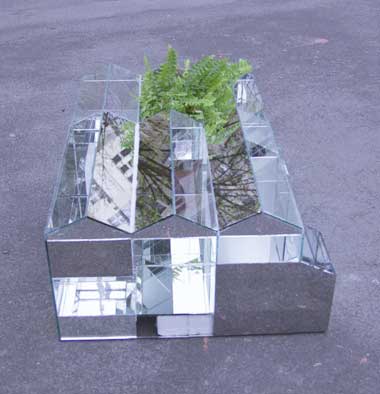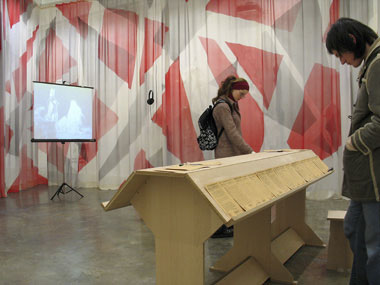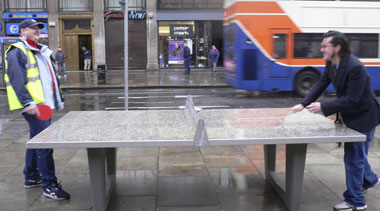 |
| Eva Berendes; Curtain, 2005: courtesy Project Arts Centre |
There is much art that wears its politics openly these days, often by demanding revisions and reconstructions of various political impulses, historical events and ‘discredited’ terms. So, in the absence of socialism … art? The Project Arts Centre has commissioned ten artists to “consider the word communism, and, moving beyond a sense of impasse, suggest ways in which this term can be materialised."
However, it could be argued that, having only depleted political programmes to draw upon, recent political art operates in a vacuum. In this context, there is a risk that ‘materialisation’ is a neutral or empty gesture, and that political content is staged, for show only; perhaps to add a little spice to otherwise insipid works. In this case, the impasse would continue and the political intentions of this exhibition would be still-born.
‘Materialisation’, then, must be about taking a position as much as providing a cultural model. The naturalistic approach, which stages political events from history so that those events might ‘speak for themselves’, shies away from taking a position: and in doing so it neutralises the complex events that it stages without interpreting, returning the past to the present in the form of a spectacular re-enactment that fails to repeat the commitment that mobilised people in the first instance.
To take a position is not so much to follow a programme external to art, but to make what art does best Ð what T J Clark has called those “wordless gestures" that are themselves political, “embedded in the matter they describe," making demands upon bodies in concrete situations, not resurrecting familiar ghosts and having them ‘speak for themselves’.
What then are we to make of Goshka Macuga’s impersonation of Lenin? The speech was delivered in the original German, reinforcing the distance between the audiences addressed by Lenin and by his imitator. And this distance is not only that of different languages. Lenin’s audience was active and potentially volatile – it was dangerous: the audience for Macuga was, of course, quite tame by comparison; perhaps looking more to be entertained than mobilised. If the intention was to revivify the original rhetoric of communism, this performance fell flat – the audience were impassive (though not because of any lack of talent on Macuga’s part). Repeated as art this radical political address was neutralised. This gives us some insight into the difficulties faced by those wishing to bring together the causes of art and politics: as art, this piece makes a powerful gesture towards, or against, a certain kind of recreational politics; but as political art, it fails to agitate, because to repeat an event of this significance in a gallery situation is to make it farcical.
So, what about the repetition of an original farce? Simultaneous to Macuga’s performance was Lali Chetwynd’s restaging of an episode from the Cabaret Voltaire . The two performances could not be more different, one would think. Eva Berendes’ curtain backdrop standing between the two would seem to reiterate this division, but in fact it draws attention to the equivalence of the two performances. In both, political action “has become reduced to theatrical exhibitionism" (Josie Appleton). The violent buffoonery and licentious provocation of the original Dada performances was intended to shock people out of their decadence and complacency, by throwing nihilism back in the face of a bankrupt society. Simply repeating a Dada performance, in the absence of those social mores that were its target, is less to violate the sensibility of oneÕs audience than to titillate it. And the cynicism and prejudice of an audience will find only confirmation in what does not provoke it, in what it can make safe by tolerating.
The carnival atmosphere of Dada performance was more than just a negative gesture; it was a return to a vulgar and shameless body, transgressing its civilised limits, and reconstituting it collectively within spasms of laughter. Chetwynd’s performance was funny and entertaining, but because it was so self-consciously artful, and so reverent towards its source, it could not be transgressive. Where once the Cabaret Voltaire was iconoclastic, irreverent, it now stands as an icon of ‘disorder’, re-ordered and contracted within the framework of arts institutions and their various aesthetic protocols.
Are we then, like ‘Pierre Menard’ attempting to write Don Quixote again from scratch in the 1930s, to anticipate “the vanity awaiting all manÕs efforts" and accept the inevitable repetition of events? If this is so, the appropriate response would be to embark consciously upon a futile act knowing that any repetition that coincides with the form of its source will always be anachronistic, and will therefore encourage some variation in interpretation. But herein lies the fiction: perhaps the truth is that history proper has not yet begun; all up to now has been a ‘pre-history’, the endless recurrence of the same old story.
The past is appropriated when its events are repeated. As an example of such, are these performances a case of dressing up current political-art practices in the garb of past revolutions in order to disguise their lack of social content, thus merely parodying the past, telling the same old story with a knowing wink; or are they a case “of finding once more the spirit of revolution, not of making its ghost walk about again" (Marx)? The revolutionary past must be appropriated and put into the service of the present, but not in form only : otherwise the present cannot arrive at its own content, facing towards the future; it cannot, as Marx said, “let the dead bury their dead."
 |
| Klaus Weber; Entwurf für Kommune, 2004: courtesy Project Arts Centre |
So, what of the future? Klaus Weber has drawn on Constructivism to build a scale model of a house of glass and mirrors, which he has called Psycho-botanic-mirror-house, draft for commune . The house is built around the principles of cybernetics, recycling, coexistence, the exploitation of renewable natural resources, and the undefined properties of certain hallucinogenic plants. Like many of the original Constructivist designs, Weber’s Draft is effective as a dream image, expressing a ‘utopian surplus’ over and above its utility. It was this surplus that maintained the gap between Constructivist dream and Soviet reality, allowing, briefly, the two to criticise one another, dream affecting reality indirectly by analogy and encouragement. When this gap was closed, when dream was forced upon reality, it was to have disastrous consequences (consequences which are, strangely, not spoken of in this exhibition: surely one needs to discuss what went wrong before one can think of putting it right?).
Can the present means represent a future that will supersede those means? Whatever dreams of the future spring from the past, and are repesented in the present cannot be other than a fiction. These dreams can be regulative, appearing at the edge of what is familiar, but they cannot be predictive. Were these dreams to be realised at present they would make a fetish of some future configuration, and they would create a sanctuary from failed social structures that would in no way break with these structures; in fact, would be their perfect ideological supplement.
As with any game, those played out in dream images continue to conjure up unexpected and different speculations regarding the future. But then, Ôwho is playing?Õ The posters and fliers for the exhibition were designed by Aleksandra Mir, showing two iconic images of the twentieth century; one of Che Guevera and one of Concorde. The resulting collage is a striking and somewhat discordant juxtaposition: but although as a mass-produced image it circumvents those awkward paradoxes that arise from autonomous and unique art objects (or artists) making reference to collective politics, a rather banal question remains: why were these fliers not distributed more widely? Why was it only the recognised members of the Dublin art world that were invited to the opening of this exhibition? Restricted to such a context, MirÕs image seems less a correlate to political engagement than to a certain unspoken relief that the cultural sector is not open to actual political disruption, oddly coupled with nostalgia for a time when it was. This protectionist policy, by which the art world manages its audience and its players, and panders to their narcissism, is insupportable at the best of times, and especially so in an exhibition that claims to re-engage with communism; a ‘term’ which, in becoming ‘materialised’, would dissolve such privileged divisions of labour. The freedom to play, it seems, remains the preserve of the few.
 |
| View of Project Arts Centre showing a video of Lali Chetwynd’s performance in the background and part of Susan Kelly’s Reading room in the foreground; courtesy Project Arts Centre |
At the core of this exhibition is Susan Kelly’s work, which once again poses Lenin’s (or Chernyshevsky’s) question “What is to be done?" Begun in Finland, this work has since travelled widely, accumulating an archive as it goes. Audiences are requested to write down their own answers to this question. These answers are varied and often contradictory, ranging from Bush-beating rants to considered essays, from the committed to the absurd to the ‘wouldn’t it be nice if …?’. There does appear to be some consensus as to who or what the enemy is; yet, as to what, how and by whom something should be done, there is no clear answer (though some responses are more feasible than others). Some responses read more like individual demonstrations of discontent that, once voiced, foreclose collective action. The absence of some shared ideology, and its replacement with an aggressive individualism seem to be the most pressing obstacles (still).
Another problem, of course, is the scarcity of art practices appropriate to collective politics. One might argue that Kelly’s work itself is a form of collective labour. But then this labour is one-sided, emphasising the intellectual, or discursive, over the more material. Kelly’s installation in Dublin takes elements from Alexander Rodchenko’s Worker’s Club Reading Room of 1925. But in Rodchenko’s interior, immaterial labour (education, etc) was bound to manual labour rather than being a refuge from it – labour itself was cognitive: its objects were responsive to the workers’ needs, making use of advances in technology in order to reconcile humans with the objects that constitute their environment. The constructivist object, for Rodchenko, was to be a ‘comrade’, another organ of human activity, mute but adjusting to people’s actions, expanding and dying with them, its shape and function continually renewed in light of new demands. In comparison, Kelly’s objects are inert, and subsequently, education and intellectual production is again split from the body that it works through. Whilst this material dimension is overlooked, the answers to ‘what is to be done?’ remain quite separate from ‘doing’.
Perhaps, then, there is a need for practices that engage more directly and on equal terms with a non-art reality, that have a sense of social purpose and involvement, and that make institutional resources available outside the art institution in everyday situations. This rationale seems to support Seamus Nolan’s bicycle workshop and renovators, and Declan Clarke and Paul McDevitt’s installation of a concrete table tennis table on O’Connell Street. Both have been immensely popular, and in this sense at least, more successful at materialising some form of collectivity than the works in the gallery.
 |
| Veit Stratmann; Chairs, 2005; courtesy Project Arts Centre |
Here, however, the familiar question of critical autonomy emerges. Like Veit Stratmann’s mobile sculpture of nine office chairs ‘joined back to back in a circle’, Clarke’s and McDevitt’s ‘monument to leisure’, though entertaining, does little more than encourage the notion of collaboration as a distraction rather than a necessity. Pace Clarke and McDevitt, the presence of a table tennis table on O’Connell Street does more to highlight hitherto unimaginative town planning than make some collective demand.
 |
| Paul McDevitt and Declan Clarke; TischTennisTisch, 2005; courtesy Project Arts Centre |
NolanÕs emphasis on non-alienated production and distribution is laudable, as is the general promotion of recycling resources and minimising environmental exploitation. There is, no doubt, a need for exchanges based upon local and substantial Ôface-to-faceÕ interactions, but we should be wary of romanticising pre-capitalist or ÔnaturalÕ economies as alternative models: ÔsolidarityÕ within such markets is often built upon a tribal basis, and therefore antithetical to communism.
Furthermore, artistic interventions need to disrupt the social narratives and conventions of the concrete situations in which they involve themselves: they need to have some ÔcorrosiveÕ effect, rather than continuing the fluid circulation of signs that supplements that of capital. ÔCorrosiveÕ forms second the demand that politics be the art of the impossible, by refusing to make demands which can be either administrated within an institution or eventually converted to the axiom of market exchange.
A problem with practices that follow the weak institutional logic of accessibility, cultural provision, social inclusion, and consensus is that they must be intelligible; they must signify without difficulty if they are not to deter their audience. To do this is not only to participate in the present Ôpost-criticalÕ, ÔpragmaticÕ culture, it is also to make the patronising assumption that the wider audience is alienated by works that are incomprehensible; that they should only be ÔchallengedÕ in small, manageable doses.
Lastly, critical culture cannot be a substitute for politics, even if its objects and its discussions are saturated by politic motivations, strategies, etc. Culture does not constitute politics as such: strategically it is weak unless it passes over into militancy; and as a method of critical analysis it was long since overtaken by science. In light of this, its most fitting role seems to be anarchic, disruptive. If labour in a neo-liberal economy is largely immaterial, then the modalities that characterise such labour Ð e.g. non-central, fluid organisation, the network Ð and which are most prominent in cultural practice, could be used as militant counter-conduct. Political art might exploit those experimental forms of organisation often found in art in order to make concrete political demands: though it m ight well supersede its status as art in the process.
Tim Stott is an art critic based in Dublin.